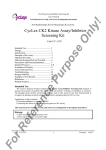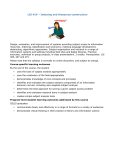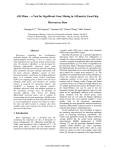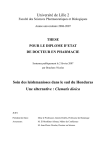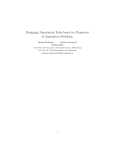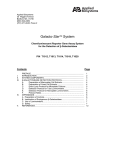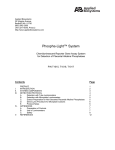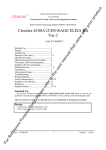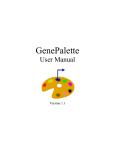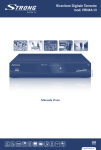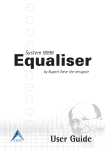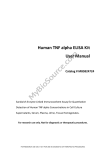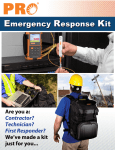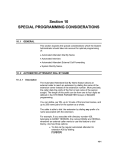Download Galacto-Light™ Plus System Protocol (PN T9003J)
Transcript
Applied Biosystems 35 Wiggins Avenue Bedford, MA 01730 (800) 542-2369 (781) 271-0045, Press 2 http://www.appliedbiosystems.com Galacto-Light Plus™ System Chemiluminescent Reporter Gene Assay System for the Detection of β-Galactosidase P/N T1007, T1011, T1009 Contents I. II. III. IV. V. PREFACE INTRODUCTION SYSTEM COMPONENTS β-GALACTOSIDASE DETECTION PROTOCOL A. Preparation of Cell Extracts from Cultured Cells B. Direct Lysis Protocol for Microplate Cultures C. Detection with Microplate Luminometers D. Detection with Tube Luminometers E. Protocol Notes APPENDICES A. Preparation of Controls B. Inactivation of Endogenous β-Galactosidase C. Use of Luminometers D. Safety REFERENCES Page 1 2 3 3 3 4 4 5 5 6 6 6 6 7 11 Part Number T9003 Revision J Revision Date: October 2008 For Research Use Only. Not for use in diagnostic procedures. Information in this document is subject to change without notice. APPLIED BIOSYSTEMS DISCLAIMS ALL WARRANTIES WITH RESPECT TO THIS DOCUMENT, EXPRESSED OR IMPLIED, INCLUDING BUT NOT LIMITED TO THOSE OF MERCHANTABILITY OR FITNESS FOR A PARTICULAR PURPOSE. TO THE FULLEST EXTENT ALLOWED BY LAW, IN NO EVENT SHALL APPLIED BIOSYSTEMS BE LIABLE, WHETHER IN CONTRACT, TORT, WARRANTY, OR UNDER ANY STATUTE OR ON ANY OTHER BASIS FOR SPECIAL, INCIDENTAL, INDIRECT, PUNITIVE, MULTIPLE OR CONSEQUENTIAL DAMAGES IN CONNECTION WITH OR ARISING FROM THIS DOCUMENT, INCLUDING BUT NOT LIMITED TO THE USE THEREOF, WHETHER OR NOT FORESEEABLE AND WHETHER OR NOT APPLIED BIOSYSTEMS IS ADVISED OF THE POSSIBILITY OF SUCH DAMAGES. Literature Citation: When describing a procedure for publication using this product, please refer to it as the Galacto-Light Plus™ System. Trademarks: Applied Biosystems, AB (Design), Dual-Light, Galacton, Galacton-Plus, Galacton-Star and Tropix are registered trademarks, and Galacto-Light, Galacto-Light Plus, Galacto-Star and Sapphire-II are trademarks of Applied Biosystems, Inc. or its subsidiaries in the US and certain other countries. All other trademarks are the sole property of their respective owners. © Copyright 2008 Applied Biosystems. All rights reserved. PREFACE Safety Information Note: For general safety information, see this Preface and Appendix D, “Safety” on page 7. When a hazard symbol and hazard type appear by a chemical name or instrument hazard, see the “Safety” Appendix for the complete alert on the chemical or instrument. Safety Alert Words Four safety alert words appear in Applied Biosystems user documentation at point in the document where you need to be aware of relevant hazards. Each alert word—IMPORTANT, CAUTION, WARNING, DANGER—implies a particular level of observation or action, as defined below: IMPORTANT! – Indicates information that is necessary for proper instrument operation, accurate chemistry kit use, or safe use of a chemical. CAUTION! – Indicates a potentially hazardous situation that, if not avoided, may result in minor or moderate injury. It may also be used to alert against unsafe practices. WARNING! – Indicates a potentially hazardous situation that, if not avoided, could result in death or serious injury. DANGER! – Indicates an imminently hazardous situation that, if not avoided, will result in death or serious injury. This signal word is to be limited to the most extreme situations. MSDSs The MSDSs for any chemicals supplied by Applied Biosystems are available to you free 24 hours a day. For instructions on obtaining MSDSs, see MSDSs on page 8. IMPORTANT! For the MSDSs of chemicals not distributed by Applied Biosystems contact the chemical manufacturer. How to Obtain Support For the latest services and support information for all locations, go to: www.appliedbiosystems.com At the Applied Biosystems web site, you can: • Access worldwide telephone and fax numbers to contact Applied Biosystems Technical Support and Sales facilities. • Search through frequently asked questions (FAQs). • Submit a question directly to Technical Support. • Order Applied Biosystems user documents, MSDSs, certificates of analysis, and other related documents. • Download PDF documents. • Obtain information about customer training. • Download software updates and patches. 1 I. INTRODUCTION The Tropix® Galacto-Light Plus™ and Galacto-Light™ (product discontinued) chemiluminescent reporter assay systems are designed for rapid and sensitive detection of β-galactosidase reporter enzyme in cell lysates. The Galacto-Light Plus reporter assay incorporates Galacton-Plus® chemiluminescent substrate for β-galactosidase with Tropix® Sapphire-II™ luminescence enhancers. The assay has a wide dynamic range, enabling detection from 2 fg to 20 ng of purified βgalactosidase (1-3). β-galactosidase detection is simple and fast. Cell lysate is incubated with reaction buffer for 15 minutes to 1 hour. Galacton-Plus substrate in the reaction buffer is cleaved by the enzyme. The sample is then placed in a luminometer and Accelerator-II is added, terminating enzyme activity and triggering light emission from the cleaved substrate. Galacton-Plus chemiluminescent substrate emits light at a near constant level with a half-life of approximately 180 minutes after the addition of Accelerator-II. This substrate is ideal for use with instruments without reagent injectors. The Lysis Solution provided may be replaced with alternative lysis solutions and lysis procedures, if co-transfected reporters require different conditions. Alternative procedures should be compared with the Galacto-Light Plus lysis protocol to ensure optimal assay performance. The bacterial β-galactosidase gene is widely used as a reporter enzyme for the study of gene regulation, and more recently in systems for identification of protein-protein interactions. 1,2Dioxetane substrates for β-galactosidase, including Galacton® (product discontinued), Galacton-Plus and Galacton-Star® (Tropix® Galacto-Star™ system) provide highly sensitive enzyme detection and have been used widely in reporter assays in both cell and tissue extracts. The Galacton-Plus substrate is also incorporated into a combined assay for dual detection of firefly luciferase and βgalactosidase activities in the same cell extract sample (Tropix® Dual-Light® system [4]). Chemiluminescent β-galactosidase reporter assays may be conducted in cells or tissues that have endogenous enzyme activity. Endogenous activity can be significantly reduced by heat inactivation (5). Tissue extracts may require the use of protease inhibitors (6). Applications The Galacto-Light Plus™ and Galacto-Light assay systems are widely used for traditional reporter gene assays in transfected mammalian cell lines in culture (7-9), and have been used with primary culture cells (10), tissue extracts from transgenic mice (11,12), frog embryo extracts (13), Drosophila embryo extracts (14), protozoan parasites (15) and in Pseudomonas bacterial cells (16). These assay systems have also been utilized in yeast reporter gene assays (17,18), and for the study of protein:protein interactions with the yeast two-hybrid system (19,20), and DNA:protein interactions with the one-hybrid system (21). A variety of applications have been performed with mammalian cells, such as viral function assays with β-Gal-encoding MAGI cells (22), and targeted gene expression for gene therapy (23). A novel β-galactosidase peptide complementation system utilizing Galacton-Plus substrate has been used in mammalian cells to detect intracellular protein-protein interactions (24,25). In addition, βgalactosidase peptide complementation has been used in an assay for myoblast cell fusion in cell culture (24,26). Cytotoxicity has been monitored by measurement of β-gal reporter enzyme released into culture media (27), and an mRNA trans-splicing assay in primary fetal fibroblasts was performed by measuring reconstitution of β-Gal activity from partial RNA transcripts (28). The Galacto-Light Plus™ assay system has wide application to assays that use the β-gal reporter as a functional read-out, enabling highly sensitive detection in many different types of cells and organisms. 2 II. SYSTEM COMPONENTS Galacto-Light Plus™ kits (P/Ns T1007 / T1011 / T1009) utilize Galacton-Plus substrate and Accelerator-II. Shelf-life for all kits is 1 yr at 4°C. Microplate assays per kit Lysis Solution Substrate Solution Reaction Buffer Diluent Accelerator III. T1007 600 70 mL 0.4 mL 40 mL 70 mL T1011 1800 210 mL 1.2 mL 120 mL 210 mL T1009 15,000 1.75 L 10 mL 1L 1.75 L 1. Lysis Solution: 100 mM potassium phosphate pH 7.8, 0.2% Triton X-100. 2. Chemiluminescent Substrate: Galacton-Plus® 100X concentrate. 3. Reaction Buffer Diluent: 100 mM sodium phosphate (pH 8.0), 1 mM MgCl2. 4. Accelerator-II: Ready-to-Use reagent containing Sapphire-II™ enhancer. β-GALACTOSIDASE DETECTION PROTOCOL Please read the entire Protocol and Notes sections before proceeding. A. Preparation of Extracts from Cultured Cells Non-adherent cells should be pelleted and rinsed. Sufficient Lysis Solution should be added to cover the pellet, then cells should be resuspended by pipetting. Continue at step 5 below. For the following hazards, see the complete safety alert descriptions in Appendix D “Safety” on page 7: WARNING! CHEMICAL HAZARDS. Lysis Solution. 1. Add DTT (to 0.5 mM) to the required volume of Lysis Solution (if desired, see Note 1). 2. Rinse cell cultures twice with PBS. 3. Add Lysis Solution to cover cells. Use 250 µl per 60 mm plate. 4. Detach cells from plate with a cell scraper. 5. Transfer the cell lysate to a microfuge tube and centrifuge for 2 min to pellet debris. 6. Transfer extracts (supernatant) to a fresh tube. Use immediately or store at -70˚C. 3 B. Direct Lysis Protocol for Microplate Cultures This procedure is designed for adherent cells growing in 96-well tissue culture-treated luminometer plates. Perform assays in triplicate at room temperature. Heat inactivation of endogenous βgalactosidase activity has not been found to be effective with this protocol. For the following hazards, see the complete safety alert descriptions in Appendix D “Safety” on page 7: WARNING! CHEMICAL HAZARDS. Lysis Solution. C. 1. Add DTT (to 0.5 mM) to the required volume of Lysis Solution (if desired, see Note 1). 2. Rinse cell cultures once with PBS. 3. Add 10 μL of Lysis Solution to each well and incubate for 10 min. 4. Continue with the procedure for Detection with Microplate Luminometers (Section C), omitting Step 3. Detection with Microplate Luminometers Perform assays in triplicate at room temperature. For the following hazards, see the complete safety alert descriptions in Appendix D “Safety” on page 7: WARNING! CHEMICAL HAZARDS. Galacton-Plus substrate, Lysis Solution, Reaction Buffer Diluent, Accelerator-II. 1. Dilute Galacton-Plus substrate 1:100 with Reaction Buffer Diluent to make Reaction Buffer. Prepare only enough for one day’s use (70 μL/well). 2. Equilibrate Reaction Buffer and Accelerator-II to room temperature. 3. Transfer 2-20 µL of extract to microplate wells (see Note 2). 4. Add 70 µl of Reaction Buffer per well and incubate for 30-60 min (see Note 3). 5. Place plate in luminometer. Inject 100 µl of Accelerator-II. After a 1-2 sec delay, read signal for 0.1-1 sec/well. 4 D. Detection with Tube Luminometers Perform assays in triplicate at room temperature. For the following hazards, see the complete safety alert descriptions in Appendix D “Safety” on page 7: WARNING! CHEMICAL HAZARDS. Galacton-Plus substrate, Reaction Buffer Diluent, Accelerator-II. 1. Dilute Galacton-Plus substrate 1:100 with Reaction Buffer Diluent to make Reaction Buffer. Prepare only enough for one day’s use (200 μL/tube). 2. Equilibrate Reaction Buffer and Accelerator-II to room temperature. 3. Transfer 2-20 µL of extract to luminometer tubes (see Note 2). 4. Add 200 µl of Reaction Buffer per tube and incubate for 30-60 min (see Note 3). 5. Place tube in luminometer. Inject 300 µl of Accelerator-II. After a 1-2 sec delay, read signal for 0.1-1 sec/tube. E. Protocol Notes 1. Dithiothreitol (DTT not included) may be added to Lysis Solution (to 0.5 mM) to stabilize βgalactosidase activity. However, DTT may increase assay background, and will decrease the half-life of light emission of Galacton-Plus. If low background and extended half-life of light emission is critical (for instance, if manual addition of Accelerator-II is being used), DTT should be omitted. If DTT must be used, adding H2O2 to Accelerator-II (to 10 mM; add 1 µL of 30% H2O2 per 1 mL of Accelerator-II) will prevent rapid decay of signal half-life. 2. The amount of cell extract required depends upon the β-galactosidase expression level. Use 2-5 µl or 10-20 µl of extract for samples with high or low levels of enzyme, respectively. For reproducible results, assay the same volume of sample every time. Lysis Solution may be added to equalize sample volumes. 3. Due to the light emission kinetics of the reaction, it is important that each well have an identical incubation time prior to measurement. Reaction Buffer should be added to samples in the same sequence that they will be measured, and the timing should correspond to the timing of Accelerator-II addition/measurement for all samples. 5 IV. APPENDICES A. Preparation of Controls Positive Control Reconstitute lyophilized β-galactosidase (Sigma G-5635) to 1 mg/mL in 0.1 M sodium phosphate (pH 7.0), 0.1% BSA. Store at 4°C. Generate a standard curve by serially diluting in Lysis Solution containing 0.1% BSA. 2-20 ng of enzyme should be used as an upper detection limit. Purified enzyme provides a positive control for the assay reagents, as well as a means to determine the range of detection of the luminometer instrumentation, if desired. The purified enzyme standard curve is not intended (or accurate) for absolute quantitation of reporter enzyme concentrations, as the specific activity of the purified enzyme preparation and the reporter enzyme may differ significantly. Additional positive controls can include use of control β-galactosidase constructs that provide constitutive expression of reporter enzyme as a positive control for cell transfection. Negative Control Assay a volume of mock-transfected extract equivalent to that of experimental extract to determine endogenous cellular background. In experiments involving induction of reporter expression, uninduced cells should be assayed as a negative control for total assay background. B. Inactivation of Endogenous β-Galactosidase Some cell lines exhibit endogenous β-galactosidase activity. This may lead to high background which will decrease the sensitivity of the assay. A procedure for heat inactivation of endogenous βgalactosidase activity has been described (5). A modified version of this protocol has also been described for use with tissue extracts in which protease inhibitors are used in conjunction with the heat inactivation procedure (6). These procedures should be performed prior to the Detection Protocol. Inactivation of β-Galactosidase Activity 1. Heat the extract for 50-60 min at 48°C. 2. Proceed with detection (Section IIIC or IIID). NOTE: PMSF (to 0.2 mM) and leupeptin (to 5 µg/mL) may be added to Lysis Solution just before use if protease activity may be present. NOTE: AEBSF (a water-soluble analog of PMSF; Sigma A-8456) may replace of PMSF (Sigma P7626). Leupeptin (Sigma L-2884) is recommended. C. Use of Luminometers We recommend using a single-mode luminometer or a multi-mode detection insturment set for luminescence measurement to measure the light emission from 96- or 384-well microplates. The linear range of detection will vary according to cell type and on the reporter enzyme expression level. The number of cells or sample volume used per well should be optimized to prevent a measurement signal that is outside the linear range of the luminometer. Extremely high light signals can saturate the detector (very unlikely for experimental samples), resulting in erroneous measurements. Refer to your luminometer user’s manual, and use the positive control serial dilution curve to determine the upper limit for your specific luminometer. Contact Applied Biosystems Technical Support for additional questions. 6 D. Safety 1. GENERAL CHEMICAL SAFETY Chemical hazard warning WARNING! CHEMICAL HAZARD. Before handling any chemicals, refer to the Material Safety Data Sheet (MSDS) provided by the manufacturer, and observe all relevant precautions. WARNING! CHEMICAL HAZARD. All chemicals in the instrument, including liquid in the lines, are potentially hazardous. Always determine what chemicals have been used in the instrument before changing reagents or instrument components. Wear appropriate eyewear, protective clothing, and gloves when working on the instrument. WARNING! CHEMICAL HAZARD. Four-liter reagent and waste bottles can crack and leak. Each 4-liter bottle should be secured in a low-density polyethylene safety container with the cover fastened and the handles locked in the upright position. Wear appropriate eyewear, clothing, and gloves when handling reagent and waste bottles. WARNING! CHEMICAL STORAGE HAZARD. Never collect or store waste in a glass container because of the risk of breaking or shattering. Reagent and waste bottles can crack and leak. Each waste bottle should be secured in a low-density polyethylene safety container with the cover fastened and the handles locked in the upright position. Wear appropriate eyewear, clothing, and gloves when handling reagent and waste bottles. Chemical safety guidelines To minimize the hazards of chemicals: • Read and understand the Material Safety Data Sheets (MSDSs) provided by the chemical manufacturer before you store, handle, or work with any chemicals or hazardous materials. (See “About MSDSs” on page 8.) • Minimize contact with chemicals. Wear appropriate personal protective equipment when handling chemicals (for example, safety glasses, gloves, or protective clothing). For additional safety guidelines, consult the MSDS. • Minimize the inhalation of chemicals. Do not leave chemical containers open. Use only with adequate ventilation (for example, fume hood). For additional safety guidelines, consult the MSDS. • Check regularly for chemical leaks or spills. If a leak or spill occurs, follow the manufacturer’s cleanup procedures as recommended in the MSDS. • Comply with all local, state/provincial, or national laws and regulations related to chemical storage, handling, and disposal. 7 2. MSDSs About MSDSs Chemical manufacturers supply current Material Safety Data Sheets (MSDSs) with shipments of hazardous chemicals to new customers. They also provide MSDSs with the first shipment of a hazardous chemical to a customer after an MSDS has been updated. MSDSs provide the safety information you need to store, handle, transport, and dispose of the chemicals safely. Each time you receive a new MSDS packaged with a hazardous chemical, be sure to replace the appropriate MSDS in your files. Obtaining MSDSs The MSDS for any chemical supplied by Applied Biosystems is available to you free 24 hours a day. To obtain MSDSs: 1. Go to www.appliedbiosystems.com, click Support, then select MSDS. 2. In the Keyword Search field, enter the chemical name, product name, MSDS part number, or other information that appears in the MSDS of interest. Select the language of your choice, then click Search. 3. Find the document of interest, right-click the document title, then select any of the following: • Open – To view the document • Print Target – To print the document • Save Target As – To download a PDF version of the document to a destination that you choose Note: For the MSDSs of chemicals not distributed by Applied Biosystems, contact the chemical manufacturer. 3. CHEMICAL WASTE SAFETY Chemical waste hazards CAUTION! HAZARDOUS WASTE. Refer to Material Safety Data Sheets and local regulations for handling and disposal. WARNING! CHEMICAL WASTE HAZARD. Wastes produced by Applied Biosystems instruments are potentially hazardous and can cause injury, illness, or death. 8 WARNING! CHEMICAL STORAGE HAZARD. Never collect or store waste in a glass container because of the risk of breaking or shattering. Reagent and waste bottles can crack and leak. Each waste bottle should be secured in a low-density polyethylene safety container with the cover fastened and the handles locked in the upright position. Wear appropriate eyewear, clothing, and gloves when handling reagent and waste bottles. Chemical waste safety guidelines To minimize the hazards of chemical waste: • Read and understand the Material Safety Data Sheets (MSDSs) provided by the manufacturers of the chemicals in the waste container before you store, handle, or dispose of chemical waste. • Provide primary and secondary waste containers. (A primary waste container holds the immediate waste. A secondary container contains spills or leaks from the primary container. Both containers must be compatible with the waste material and meet federal, state, and local requirements for container storage.) • Minimize contact with chemicals. Wear appropriate personal protective equipment when handling chemicals (for example, safety glasses, gloves, or protective clothing). For additional safety guidelines, consult the MSDS. • Minimize the inhalation of chemicals. Do not leave chemical containers open. Use only with adequate ventilation (for example, fume hood). For additional safety guidelines, consult the MSDS. • Handle chemical wastes in a fume hood. • After emptying a waste container, seal it with the cap provided. • Dispose of the contents of the waste tray and waste bottle in accordance with good laboratory practices and local, state/provincial, or national environmental and health regulations. Waste disposal If potentially hazardous waste is generated when you operate the instrument, you must: • Characterize (by analysis if necessary) the waste generated by the particular applications, reagents, and substrates used in your laboratory. • Ensure the health and safety of all personnel in your laboratory. • Ensure that the instrument waste is stored, transferred, transported, and disposed of according to all local, state/provincial, and/or national regulations. IMPORTANT! Radioactive or biohazardous materials may require special handling, and disposal limitations may apply. 9 4. BIOLOGICAL HAZARD SAFETY General biohazard WARNING! BIOHAZARD. Biological samples such as tissues, body fluids, infectious agents, and blood of humans and other animals have the potential to transmit infectious diseases. Follow all applicable local, state/provincial, and/or national regulations. Wear appropriate protective equipment, which includes but is not limited to: protective eyewear, face shield, clothing/lab coat, and gloves. All work should be conducted in properly equipped facilities using the appropriate safety equipment (for example, physical containment devices). Individuals should be trained according to applicable regulatory and company/institution requirements before working with potentially infectious materials. Read and follow the applicable guidelines and/or regulatory requirements in the following: – U.S. Department of Health and Human Services guidelines published in Biosafety in Microbiological and Biomedical Laboratories (stock no. 017-040-00547-4; bmbl.od.nih.gov) – Occupational Safety and Health Standards, Bloodborne Pathogens (29 CFR§1910.1030; www.access.gpo.gov/nara/cfr/waisidx_01/29cfr1910a_01.html). – Your company’s/institution’s Biosafety Program protocols for working with/handling potentially infectious materials. IMPORTANT! Additional information about biohazard guidelines is available at: www.cdc.gov 5. CHEMICAL ALERTS For the definitions of the alert words IMPORTANT, CAUTION, WARNING, and DANGER, see “Safety alert words” on page 1. General alerts for all chemicals EXAMPLE: Avoid contact with (skin, eyes, and/or clothing). Read the MSDS, and follow the handling instructions. Wear appropriate protective eyewear, clothing, and gloves. 10 Specific chemical alerts WARNING! CHEMICAL HAZARD. Accelerator causes skin and respiratory tract irritation, and causes eye burns. Harmful if swallowed or absorbed through skin. May cause allergic reaction. Avoid breathing vapor. Use with adequate ventilation. Avoid contact with eyes and skin. Read the MSDS, and follow the handling instructions. Wear appropriate protective eyewear, clothing, and gloves. WARNING! CHEMICAL HAZARD. Accelerator-II causes skin and respiratory tract irritation, and causes eye burns. Harmful if swallowed or absorbed through skin. May cause allergic reaction. Avoid breathing vapor. Use with adequate ventilation. Avoid contact with eyes and skin. Read the MSDS, and follow the handling instructions. Wear appropriate protective eyewear, clothing, and gloves. WARNING! CHEMICAL HAZARD. Galacton-Plus substrate may cause eye, skin, and respiratory tract irritation. Read the MSDS, and follow the handling instructions. Wear appropriate protective eyewear, clothing, and gloves. WARNING! CHEMICAL HAZARD. Lysis Solution causes eye, skin, and respiratory tract irritation. Avoid breathing vapor. Use with adequate ventilation. Avoid contact with eyes and skin. Read the MSDS, and follow the handling instructions. Wear appropriate protective eyewear, clothing, and gloves. WARNING! CHEMICAL HAZARD. Reaction Buffer Diluent may cause eye, skin, and respiratory tract irritation. Read the MSDS, and follow the handling instructions. Wear appropriate protective eyewear, clothing, and gloves. WARNING! CHEMICAL HAZARD. Substrate Solution may cause eye, skin, and respiratory tract irritation. Read the MSDS, and follow the handling instructions. Wear appropriate protective eyewear, clothing, and gloves. V. REFERENCES 1. 2. 3. 4. 5. 6. Jain, VK and IT Magrath (1991). A chemiluminescent assay for quantitation of β-galactosidase in the femtogram range: Application to quantitation of β-galactosidase in lacZ-transfected cells. Anal Biochem 199:119-124. Bronstein, I, J Fortin, JC Voyta, CEM Olesen and LJ Kricka (1994). Chemiluminescent reporter gene assays for β-galactosidase, β-glucuronidase and secreted alkaline phosphatase, p. 20-23. In Bioluminescence and Chemiluminescence: Fundamentals and Applied Aspects (Campbell, AK, Kricka, LJ and Stanley, PE, eds), John Wiley, Chichester, England. Bronstein, I, CS Martin, JJ Fortin, CEM Olesen and JC Voyta (1996). Chemiluminescence: sensitive detection technology for reporter gene assays. Clin Chem 42(9):1542-1546. Martin, CS, PA Wight, A Dobretsova and I Bronstein (1996). Dual luminescence-based reporter gene assay for luciferase and β-galactosidase. BioTechniques 21(3):520-524. Young, DC, SD Kingsley, KA Ryan and FJ Dutko (1993). Selective inactivation of eukaryotic βgalactosidase in assays for inhibitors of HIV-1 TAT using bacterial β-galactosidase as a reporter enzyme. Anal Biochem 215:24-30. Shaper, N, A Harduin-Lepers and JH Shaper (1994). Male germ cell expression of murine β4galactosyltransferase. A 796-base pair genomic region, containing two cAMP-responsive element (CRE)-like elements, mediates male germ cell-specific expression in transgenic mice. J Biol Chem 269: 25165-25171. 11 7. 8. 9. 10. 11. 12. 13. 14. 15. 16. 17. 18. 19. 20. 21. 22. 23. 24. 25. 26. 27. 28. Graslund, T, X Li, L Magnenat, M Popkov and CF Barbas III (2005). Exploring strategies for the design of artificial transcription factors. J Biol Chem 280(5):3707-3714. Yeamans, C, D Wang, I P-P, BE Torbett, DG Tenen and AD Friedman (2007). C/EBPα binds and activates the PU.1 distal enhancer to induce monocyte lineage commitment. Hematopoiesis 110(9):3136-3142. Edenberg, HJ, J Wang, H Tian, S Pochareddy, X Xuei, L Wetherill, A Goate, T Hinrichs, S Kuperman, JI Nurnberger Jr, M Schuckit, JA Tischfield and T Foroud (2008). A regulatory variation in OPRK1, the gene encoding the κ–opioid receptor, is associated with alcohol dependence. Hum Mol Gen 17(12):1783-1789. Saller, RM, F Ozturk, B Salmons and WH Gunzburg (1998). Construction and characterization of a hybrid mouse mammary tumor virus/murine leukemia virus-based retroviral vector. J Virol 72(2):1699-1703. Ryan, AJ, K Fisher, CP Thomas and RK Mallampalli (2004). Transcriptional repression of the CTP:phosphocholine cytidyltransferase gene by sphingosine. Biochem J 382:741-750. Xu, L, L Renaud, JG Mller, CF Baicu, DD Bonnema, H Zhou, CS Kappler, SW Kubalak, MR Zile, SJ Conway and DR Menick (2006). Regulation of Ncx1 expression: Identification of regulatory elements mediating cardiac-specific expression and up-regulation. J Biol Chem 281(45):34430-34440. Gove, C, M Walmsley, S Nijjar, D Bertwistle, M Guille, G Partington, A Bomford and R Patient (1997). Over-expression of GATA-6 in Xenopus embryos blocks differentiation of heart precursors. EMBO J 16(2):355-368. Liu, Q-X, M Jindra, H Ueda, Y Hiromi and S Hirose (2003). Drosophila MBF1 is a co-activator for Tracheae Defective and contributes to the formation of tracheal and nervous systems. Development 130:719-728. Beetham, JK, KS Myung, JJ McCoy, ME Wilson and JE Donelson (1997). Glycoprotein 46 mRNA abundance is post-transcriptionally regulated during development of Leishmania chagasi promastigotes to an infectious form. J Biol Chem 272(28):17360-17366. Yarwood, JM, EM Volper and EP Greenberg (2005). Delays in Pseudomonas aeruginosa quorumcontrolled gene expression are conditional. Proc Natl Acad Sci USA 102(25):9008-9013. Remacle, JE, G Albrecht, R Brys, GH Braus and D Huylebroeck (1997). Three classes of mammalian transcription activation domain stimulate transcription in Schizosaccharomyces pombe. EMBO J 16(18):5722-5729. Stoldt, VR, A Sonneborn, CE Leuker and JF Ernst (1997). Efg1p, an essential regulator of morphogenesis of the human pathogen Candida albicans, is a member of a conserved class of bHLH proteins regulating morphogenetic processes of fungi. EMBO J 16(18):1982-1991. Bourne, Y, MH Watson, MJ Hickey, W Holmes, W Rocque, SI Reed and JA Tainer (1996). Crystal structure and mutational analysis of the human CDK2 kinase complex with cell-cycle regulatory protein CksHs1. Cell 84:863-874. Schumacher, S, K Laass, S Kant, Y Shi, A Visel, AD Gruber, A Kotlyarov and M Gaestel (2004). Scaffolding by ERK3 regulates MK5 in development. EMBO J 23:4770-4779. Wolf, SS, K Roder and M Schweizer (1996). Construction of a reporter plasmid that allows expression libraries to be exploited for the one-hybrid assay system. BioTechniques 20(4):568-573. Neurath, AR, N Strick and Y-Y Li (2002). Anti-HIV-1 activity of anionic polymers: a comparative study of candidate microbicides. BMC Infectious Diseases 2:27 (www.biomedcentral.com/1471-2334/2/27). Ozturk-Winder, F, M Renner, D Klein, M Muller, B Salmons and WH Gunzburg (2002). The murine whey acidic protein promoter directs expression to human mammary tumors after retroviral transduction. Cancer Gene Ther 9:421-431. Mohler, WA and HM Blau (1996). Gene expression and cell fusion analyzed by lacZ complementation in mammalian cells. Proc Natl Acad Sci USA 93:12423-12427. Rossi, F, CA Charlton and HM Blau (1997). Monitoring protein-protein interactions in intact eukaryotic cells by β-galactosidase complementation. Proc Natl Acad Sci USA 94:8405-8410. Charlton, CA, WA Mohler, GL Radice, RO Hynes and HM Blau (1997). Fusion competence of myoblasts rendered genetically null for N-cadherin in culture. J Cell Biol 138:331-336. Schäfer, H, A Schäfer, AF Kiderlen, KN Masihi and R Burger (1997). A highly sensitive cytotoxicity assay based on the release of reporter enzymes, from stably transfected cell lines. J Immunol Methods 204:89-98. Duan, D, Y Yue and JF Engelhardt (2001). Expanding AAV packaging capacity with trans-splicing or overlapping vectors: A quantitative comparison. Mol Therapy 4(4):383-391. For complete, updated reference list, please see http://www.appliedbiosystems.com (Product & Service Literature). 12














